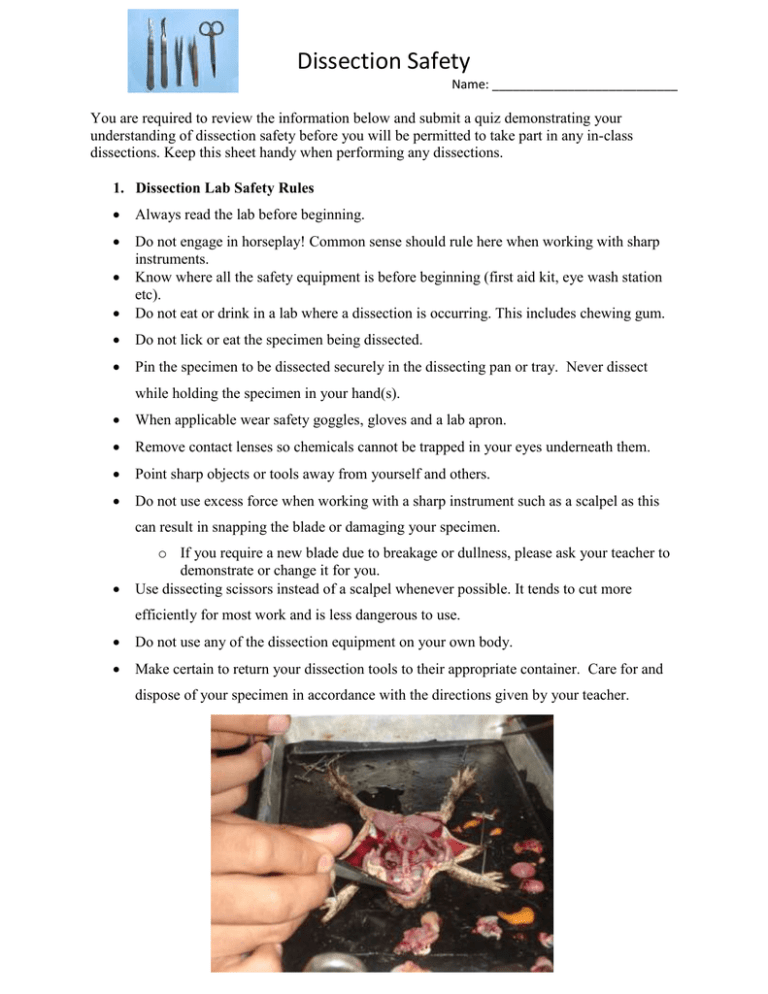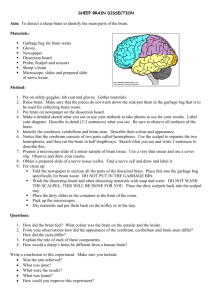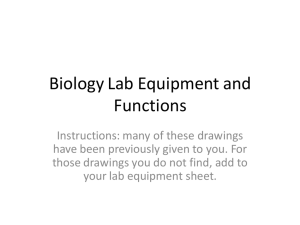Dissection Safety Quiz
advertisement

Dissection Safety Name: ___________________________ You are required to review the information below and submit a quiz demonstrating your understanding of dissection safety before you will be permitted to take part in any in-class dissections. Keep this sheet handy when performing any dissections. 1. Dissection Lab Safety Rules Always read the lab before beginning. Do not engage in horseplay! Common sense should rule here when working with sharp instruments. Know where all the safety equipment is before beginning (first aid kit, eye wash station etc). Do not eat or drink in a lab where a dissection is occurring. This includes chewing gum. Do not lick or eat the specimen being dissected. Pin the specimen to be dissected securely in the dissecting pan or tray. Never dissect while holding the specimen in your hand(s). When applicable wear safety goggles, gloves and a lab apron. Remove contact lenses so chemicals cannot be trapped in your eyes underneath them. Point sharp objects or tools away from yourself and others. Do not use excess force when working with a sharp instrument such as a scalpel as this can result in snapping the blade or damaging your specimen. o If you require a new blade due to breakage or dullness, please ask your teacher to demonstrate or change it for you. Use dissecting scissors instead of a scalpel whenever possible. It tends to cut more efficiently for most work and is less dangerous to use. Do not use any of the dissection equipment on your own body. Make certain to return your dissection tools to their appropriate container. Care for and dispose of your specimen in accordance with the directions given by your teacher. 2. Dissection Tools and Functions Name A – Scalpel and disposable blade B – Surgical scissors D – Anatomical Forceps F – Curved Forceps H – Probe Function Used for general cutting open of skin and tissue layers. Used for general cutting of skin. Also used for spreading tissue layers. Used for holding delicate structures. Used to clean nerves and arteries through fat and fascia. Used to manipulate or to probe larger openings. Fascia - is a layer of fibrous connective tissue that surrounds muscles, groups of muscles, blood vessels, and nerves, binding some structures together, while permitting others to slide smoothly over each other. 3. Key Anatomical Directional Terms: Anterior: Front Posterior: Rear, behind Distal: Away from, farther from the origin Proximal: Near, closer to the origin Dorsal: Near the upper surface, toward the back, top Ventral: Toward the bottom, toward the belly Superior: Above, over Inferior: Below, under Lateral: Toward the side, away from the mid-line Medial: Toward the mid-line, middle Rostral: Toward the front Caudal: Toward the back, toward the tail /15 Dissection Safety Quiz Name: ___________________ Date: ___________________ 1. What is the most important thing to do before starting a lab? a. Put on goggles b. Put on gloves c. Pick up all your lab materials d. Read through the entire lab 2. Why is your answer above the most important step? ________________________________________________________________________ ________________________________________________________________________ ________________________________________________________________________ 3. Which of the following instruments is primarily used for cutting skin and connective tissues and should always be pointed away from yourself and other people? a. Surgical Scissors b. Scalpel c. Anatomical Forceps d. Curved Forceps 4. What are three safety features found in this science lab? ________________________________________________________________________ ________________________________________________________________________ 5. What safety equipment should you be wearing when participating in a dissection? (list all) ________________________________________________________________________ True or False _________ 1. It is safe to eat and drink in the lab while performing a dissection. _________ 2. You shouldn’t wear contacts when performing a dissection. _________ 3. You should always try to use dissecting scissors instead of a scalpel if possible. _________ 4. You should dissect your specimen while holding it in your hands. _________ 5. If you break a scalpel blade you should try to change it yourself. _________ 6. Using a scalpel requires you to be forceful to cut through multiple layers of tissue. _________ 7. A probe can be used to look into your lab partner’s nose and mouth. ANSWERS 1. What is the most important thing to do before starting a lab? a. Put on goggles b. Put on gloves c. Pick up all your lab materials d. Read through the entire lab 2. Why is your answer above the most important step? To ensure you know all the necessary steps to the lab before proceeding. You need to be aware of the safety precautions and the order you need to follow to complete the lab successfully. 3. Which of the following instruments is used for cutting skin and tissues and should always be pointed away from yourself and other people? a. Surgical Scissors b. Scalpel c. Anatomical Forceps d. Curved Forceps 4. What are three safety features found in this science lab? Shower First aid kit Eye wash station 5. What safety equipment should you be wearing when participating in a dissection? Gloves Goggles Lab coat / apron True or False FALSE 1. It is safe to eat and drink in the lab while performing a dissection. TRUE 2. You shouldn’t wear contacts when performing a dissection. TRUE 3. You should always try to use dissecting scissors instead of a scalpel if possible. FALSE 4. You should dissect your specimen while holding it in your hands. FALSE 5. If you break a scalpel blade you should try to change it yourself. FALSE 6. Using a scalpel requires you to be forceful to cut through multiple layers of tissue. FALSE 7. A probe can be used to look into your lab partner’s nose and mouth. /15 Dissection Safety Quiz B Name: ___________________ Date: ___________________ 1. What safety equipment should you be wearing when participating in a dissection? (list all) ________________________________________________________________________ 2. What are three safety features found in this science lab? ________________________________________________________________________ ________________________________________________________________________ 3. What is the most important thing to do before starting a lab? a. Put on gloves b. Read through the entire lab c. Pick up all your lab materials d. Put on goggles 4. Why is your answer above the most important step? ________________________________________________________________________ ________________________________________________________________________ ________________________________________________________________________ 5. Which of the following instruments is primarily used for cutting skin and connective tissues and should always be pointed away from yourself and other people? a. Anatomical Forceps b. Curved Forceps c. Surgical Scissors d. Scalpel True or False _________ 1. You should not wear contacts when performing a dissection. _________ 2. You should dissect your specimen while holding it in your hands. _________ 3. A probe can be used to look into your lab partner’s nose and mouth. _________ 4. It is safe to eat and drink in the lab while performing a dissection. _________ 5. If you break a scalpel blade you should try to change it yourself. _________ 6. Using a scalpel requires you to be forceful to cut through multiple layers of tissue. _________ 7. You should always try to use dissecting scissors instead of a scalpel if possible.


